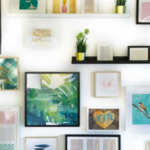
SPOTLIGHT ON A TREND; MAXIMALISM

Maximalism is a scary word in interior design. It’s a style that is as easy to get wrong as it is to get right, and often something people shy away from for fear of looking weird or different. The truth is, maximalism isn’t actually all that difficult an aesthetic to achieve; it just takes a good eye for colour and detail and a bit of patience to get the right balance.
If you aren’t already familiar, maximalism sits at the opposite end of the spectrum to minimalism. Where minimalism values pared-back décor that allows you to focus on what’s important, maximalism believes that each piece is important and that more is really more. If minimalism feels too constraining and lifeless to you, that’s a pretty good sign that you should maybe look at a more maximalist aesthetic.
Whilst the aesthetic does rely on instinct and taste, there are a few foolproof ways of making it work. The first and most important is to figure out your colour scheme early on; that way, whatever happens, the room looks cohesive. Pick colours that are opposite each other on the colour wheel to create contrast that draws the eye, but stick to those colours to ensure that the room makes sense.
Another great way of approaching maximalism is to start big and work your way down; start by picking base colours and your biggest bits of furnishings, like beds and sofas. If you’re unsure of how well this will go, you can keep the big pieces neutral, but opt for a more expressive, dramatic silhouette. Once you’ve got these in place, connect them all with matching smaller pieces, like wall art, houseplants and accessories.
If you still feel that the space is too bland, you can then add depth by introducing a variety of textured items, like cushions, rugs and throws. These various materials add visual interest without departing massively from your colour scheme, and create focal points that draw the eye.
The important thing with maximalist design is to toe the line between ‘interesting’ and ‘cluttered’. You want to display objects that interest and inspire you, without inducing feelings of stress. Try to confine your display pieces to a few key areas so that you don’t constantly feel that you’re bumping into things or looking for room, and try to keep your items within the same genre. For example, group all of your frames in one place, or if you’re displaying vases or trinkets, let them be a focal point of their own, all together in one place.
At heart, maximalism works on the same principle as minimalism; your home should contain things that make you feel happy and inspired. It also values individualism and creativity, so take all the ideas above as suggestions, rather than hard and fast rules, and follow your own creative instinct.
Maximalism is a scary word in interior design. It’s a style that is as easy to get wrong as it is to get right, and often something people shy away from for fear of looking weird or different. The truth is, maximalism isn’t actually all that difficult an aesthetic to achieve; it just takes a good eye for colour and detail and a bit of patience to get the right balance.
If you aren’t already familiar, maximalism sits at the opposite end of the spectrum to minimalism. Where minimalism values pared-back décor that allows you to focus on what’s important, maximalism believes that each piece is important and that more is really more. If minimalism feels too constraining and lifeless to you, that’s a pretty good sign that you should maybe look at a more maximalist aesthetic.
Whilst the aesthetic does rely on instinct and taste, there are a few foolproof ways of making it work. The first and most important is to figure out your colour scheme early on; that way, whatever happens, the room looks cohesive. Pick colours that are opposite each other on the colour wheel to create contrast that draws the eye, but stick to those colours to ensure that the room makes sense.
Another great way of approaching maximalism is to start big and work your way down; start by picking base colours and your biggest bits of furnishings, like beds and sofas. If you’re unsure of how well this will go, you can keep the big pieces neutral, but opt for a more expressive, dramatic silhouette. Once you’ve got these in place, connect them all with matching smaller pieces, like wall art, houseplants and accessories.
If you still feel that the space is too bland, you can then add depth by introducing a variety of textured items, like cushions, rugs and throws. These various materials add visual interest without departing massively from your colour scheme, and create focal points that draw the eye.
The important thing with maximalist design is to toe the line between ‘interesting’ and ‘cluttered’. You want to display objects that interest and inspire you, without inducing feelings of stress. Try to confine your display pieces to a few key areas so that you don’t constantly feel that you’re bumping into things or looking for room, and try to keep your items within the same genre. For example, group all of your frames in one place, or if you’re displaying vases or trinkets, let them be a focal point of their own, all together in one place.
At heart, maximalism works on the same principle as minimalism; your home should contain things that make you feel happy and inspired. It also values individualism and creativity, so take all the ideas above as suggestions, rather than hard and fast rules, and follow your own creative instinct.
Tags: Bedroom, bedroom furniture, bedroom ideas, home, homedecor
